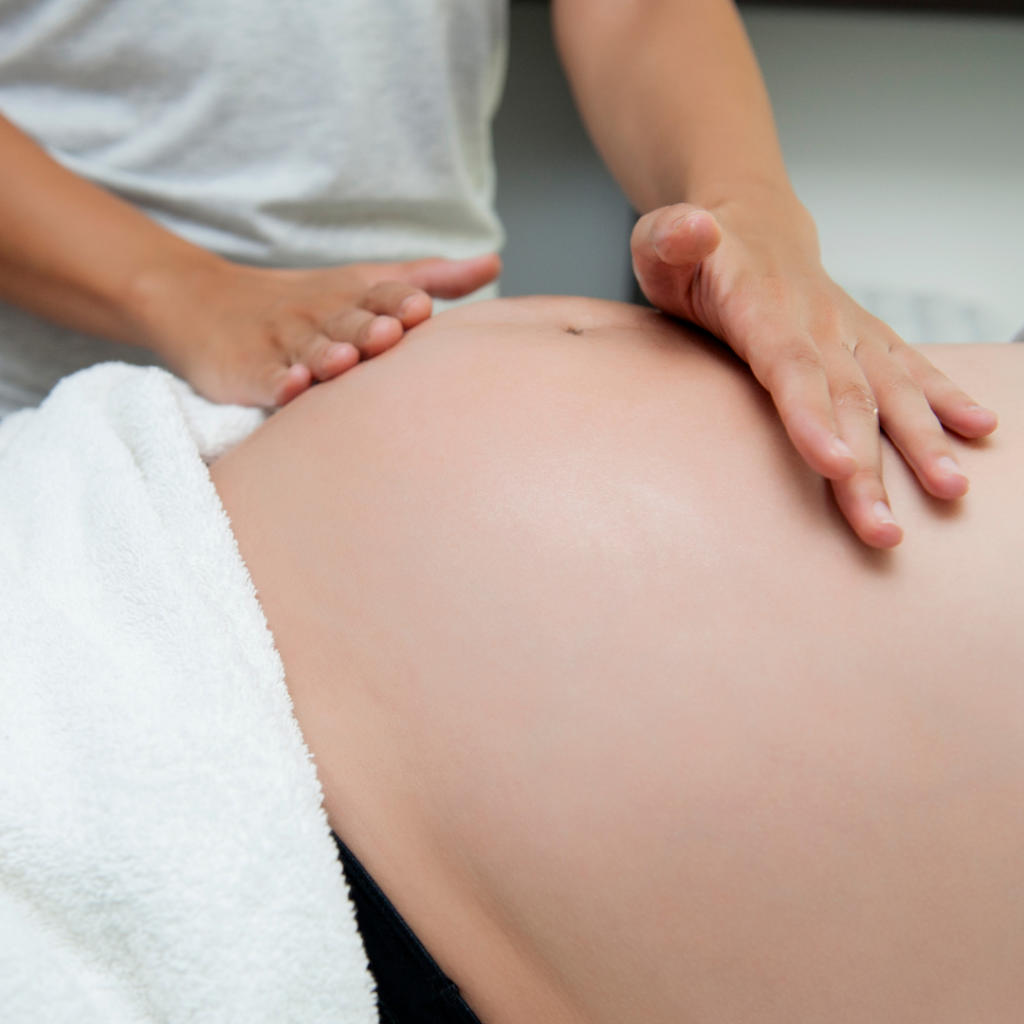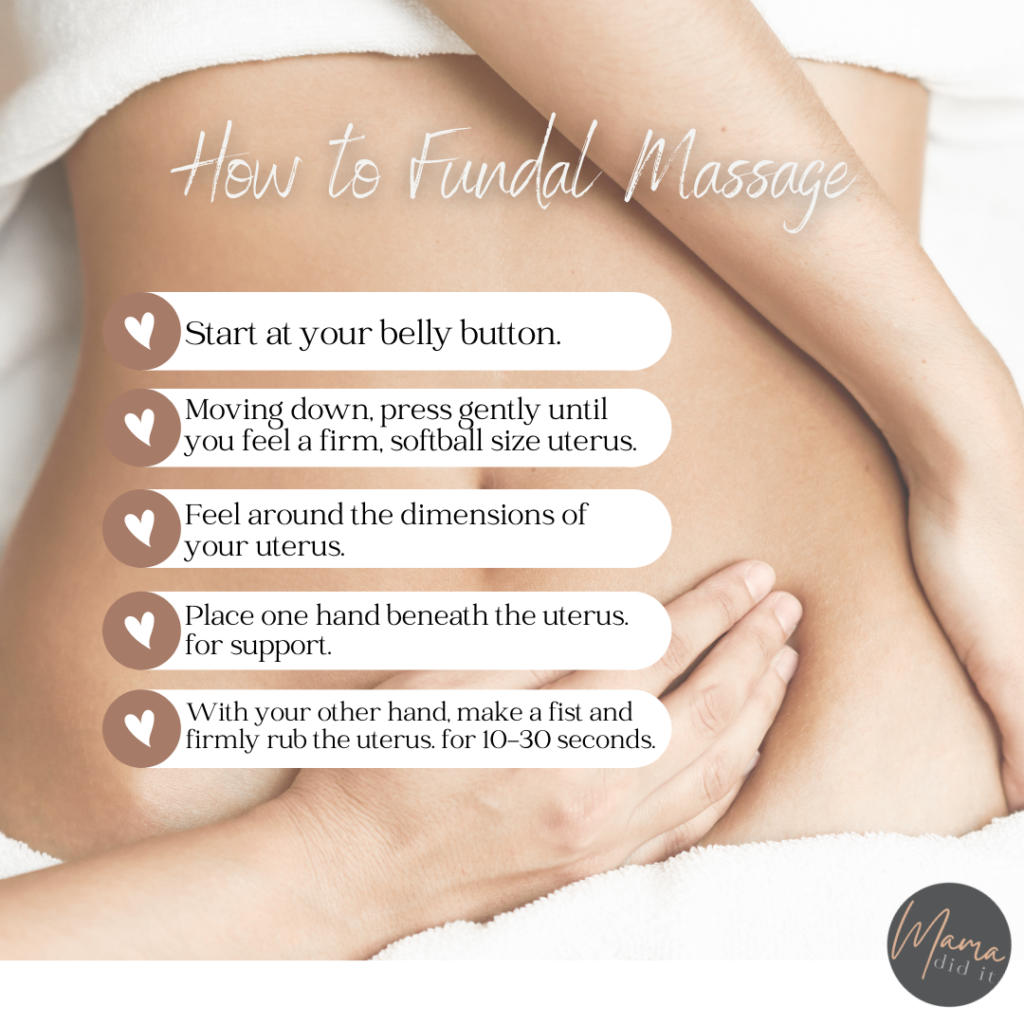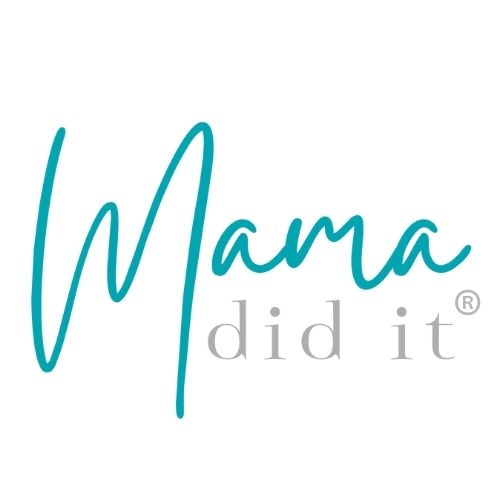The effectiveness of uterine (or fundal) massage is incredibly important for preventing postpartum hemorrhage.
When your pregnancy has reached full term and you start labor, your uterus is about the size of a watermelon. After giving birth, it shrinks down to the size of a cantaloupe. This big change can cause uterine atony (bogginess or loss of tone in the uterus) and excessive bleeding. Learning the effectiveness of uterine massage for preventing postpartum hemorrhage can help. With my experience as a mother-baby nurse, I’m going to teach you the how and why behind postpartum hemorrhage and fundal massage.
“But Rachel, why are you using the term postpartum? Aren’t you big on the term fourth trimester?” Why, yes I am. I chose to use the term postpartum on this topic because the term postpartum means “following childbirth” and the majority of postpartum hemorrhage cases happen within one day of birth. However, it can occur up to twelve weeks (so throughout the entire fourth trimester). Even though this can be a scary topic, keep in mind that postpartum hemorrhage only occurs in one to five percent of women.
See below for a step-by-step chart for how-to fundal massage.

The Effectiveness of Uterine Massage for Preventing Postpartum Hemorrhage
After a vaginal delivery, you will begin to have uterine contractions again. Approximately five to fifteen minutes later, you experience the delivery of the placenta. Many women who have an unmedicated birth describe the placental delivery as feeling “crampy and uncomfortable.” Many women who have an epidural don’t notice this happening at all. Your care providers then examine your placenta to make sure you are not at risk for retained placenta (when small pieces of the placenta fail to be expelled from the uterus) and postpartum haemorrhage. Your uterus begins to contracts to put pressure on its internal blood vessels to prevent extra bleeding. If the contractions aren’t strong enough it can put the mother at risk of postpartum hemorrhage.
Cesarean Section Delivery
After a cesarean delivery, your healthcare provider ensures your placenta is removed during surgery. They then examine it, as they do with vaginal births, and sew up your incision. Your body begins to respond and your uterus begins to contract as it does following vaginal birth. The level of postpartum bleeding may be less after a c-section. Mothers who have cesarean births typically bleed less and for a shorter amount of time than with vaginal births.
Fundal massage is important to help the uterus contract in order to reduce the amount of blood loss you experience after the delivery of the baby. It gives a boost to what your body is already trying to accomplish. If synthetic oxytocin is given, as is the case in many hospitals, this will also aid in keeping the uterus contract and prevent heavy bleeding. Breastfeeding your newborn also releases natural oxytocin that aids in keeping your uterus contracted. Uterine atony (bogginess) is a common cause of postpartum hemorrhage, and the effect of the uterine massage can make a significant difference.

What is postpartum hemorrhage?
According to the March of Dimes, postpartum hemorrhage is serious, excessive bleeding after giving birth. It usually happens within one day of birth, but can happen up to twelve weeks after delivery. It is rare, only happening in one to five percent of women, but requires immediate medical attention.
What causes postpartum hemorrhage and how is it treated?
A mother may have a greater risk of postpartum hemorrhage, uncontrolled bleeding if she gives birth to a large baby. Risk factors also include an early detachment of the placenta, placental abruption, or previous births. Postpartum hemorrhage can be uncontrolled bleeding, an excessive amount of bleeding, blood clots, or all of the above. This cause of bleeding can result in excessive postpartum blood loss.
Fundal massage is our first line of defense, as well as common treatment, but if the uterus is not responding well or quickly enough, hospital settings intervene with medications that slow bleeding and cause the uterus to clamp down.
For emergency care with severe cases whose bleeding doesn’t respond to other measures, a bakri balloon may be inserted to hold pressure to the inside of the uterus. A bakri balloon (or foley catheter) is inserted into the uterus by a physician and is then inflated to apply pressure to the inside of the uterus. It acts much like holding pressure to a bleeding injury that we would experience in everyday life, like a mild cut from the top of a soup can. Blood products may also be given in cases of much blood loss to increase a mother’s red blood cell count again. This may help prevent a dangerous drop in blood pressure as well as signs and symptoms of shock.
The good news is that most mothers who experience postpartum hemorrhage experience full recovery.
The Effectiveness of Uterine Massage for Preventing Postpartum Hemorrhage
I’ve been surprised in the past when patients describe fundal massage as “my nurse presses on my belly.” Many don’t understand why we do it or what we are doing. All they know is that it’s necessary and uncomfortable. Fundal massage is when we support the uterus with one hand and use the other to firmly massage the top of the uterus. The top of the uterus is called the fundus, hence the term “fundal massage.”
This rubbing and massaging will cause contractions, “after birth pains,” that help the uterus stay firm and reduce the risk of postpartum hemorrhage. These contractions are not as painful as labor contractions, but still unpleasant. Fundal massage is initially performed every few minutes after birth, slowly spacing out the increments of time as you recover. Your nurse will then assess your bleeding to make sure it isn’t excessive. At times, fundal massage may be done outside of the normal time windows as it can help the uterus expel clots.

The Effectiveness of Uterine Massage for Preventing Postpartum Hemorrhage
How to Fundal Massage
You can do your own fundal massage as well. The top of your uterus is usually found midline at your belly button the day you give birth. If recovery is going as planned, your uterus should drop one fingerbreadth each day. So, on day one postpartum, you should be able to feel your uterus one finger length below your belly button. Day two should be two fingerbreadths, and so on until your uterus is too deep for you to feel anymore. This usually happens by day five. Ask your nurse to help you feel where your uterus is. Your uterus should feel like a firm “fist” and should also be midline in your abdomen. When it’s kicked off to the side a bit, you may need to empty your bladder. This can be true even if you don’t feel you have to urinate.
Fundal massage is typically done for less than one minute but may be done for several minutes if the uterus is excessively boggy. Though uncomfortable, this will help prevent excessive bleeding. A side note here: when performing fundal massage, lightly or barely rubbing your belly will not cause your uterus to contract. It must be firm, pushing pressure to make your uterus respond.
Remember, nursing your baby also releases oxytocin that helps your uterus contract. You will feel more cramps as you nurse. Also, you may notice extra vaginal bleeding. This is normal and helps your uterus shrink back down to its normal size.
How much fundal massage is too much?
Fundal massage should be done every few minutes as needed and for several minutes at a time for a boggy uterus. As your uterus recovers from childbirth, fundal massage is needed less and less because the uterus is doing the work it should be. Your nurse helps make sure of this by assessing the position and size of your fundus every few minutes immediately following birth and then every few hours. Your chance of postpartum hemorrhage after day one decreases dramatically. Continue to do fundal massage for several days to help ensure the uterus is firm. The uterus slips too deep back into the pelvis for fundal massage to really be effective after the first few days of birth. At that point, you would just be rubbing on your lower abdomen.

When should I call my doctor postpartum?
If your vaginal bleeding begins soaking a heavy size period pad in one hour, it’s too much. Passing clots larger than a golf ball warrants a call to your doctor right away. If you experience a drop in blood pressure or signs of shock, such as blurry vision, chills, pale skin, fast heartbeat, weakness, dizziness, or passing out, call 911. Do not wait. Besides a little extra soreness when you get home (because we tend to do more at home), you should be getting better and better following childbirth. If you have any setbacks or your pain gets worse, don’t hesitate to give your healthcare provider a call to make sure you are within the normal limits of recovery. Trust your instincts! If you feel something is wrong, please call.
You may also like What is the Fourth Trimester of Pregnancy? or 7 Things You Should Know About Sex After Birth
